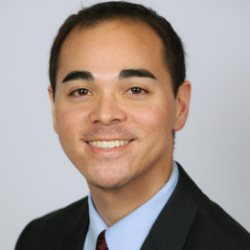With 66% of U.S. adults using prescription drugs, pharmacists play a key role in keeping patients safe and helping them achieve therapeutic goals. The pharmacist’s role evolves with health care, such as during the ongoing COVID-19 pandemic. How can prescribers and pharmacists best partner with one another? Doximity had the pleasure of speaking with Julie Justo, PharmD, an inpatient clinical pharmacist who specializes in infectious diseases (ID) and antimicrobial stewardship, on how she works independently and with a team to optimize patient care.
Doximity: What is a typical work day for you?
Julie Justo, PharmD: My days are varied based on the hospital service I am covering. If I’m on the ID consult service, I work up the patients the team is following alongside other health care professionals on the team. My focus is on looking for any ways to optimize drug therapy. Because I’m a clinical educator, I usually meet with my pharmacy students, residents, and possibly fellows to pre-round on their assigned patients and ensure their care plans are appropriate and optimal. We then join the entire team for bedside patient rounds in the afternoon and assist with the development and implementation of care plans.
If I’m on the antimicrobial stewardship service, which is led by a pharmacist such as myself, I spend the morning performing prospective audits and [giving] feedback on all targeted alerts throughout the hospital (e.g., positive multiplex PCRs or cultures in the bloodstream, medication orders for select antimicrobials, cultures positive for multidrug-resistant organisms). I will then lead rounds with my team (often comprised of an ID fellow physician, pharmacy students, and pharmacy residents) and allow them to present their suggested interventions and care plans for patients our team is following. The afternoon is spent communicating and implementing recommended interventions and working on broader projects/policies/guidelines for the health system related to antimicrobial use. We work closely with the ID consult team and may recommend the primary medical team consult the ID service for more complex cases, especially diagnostic dilemmas that are past the scope of practice for a pharmacist.
Dox: How are prescribing clinicians (physicians/NPs/PAs) involved in your workflow and patient care?
JJ: My job is to identify any opportunities to optimize medication therapy, specifically antimicrobial therapy. This can include agent selection, dosage adjustments, drug interaction management, pharmacokinetic monitoring, other monitoring for efficacy/toxicity, duration of therapy, transitions of care to the outpatient setting — including cost/availability of various antimicrobials based on the patient’s medical insurance coverage, etc. I work with clinicians throughout the day to understand their differential diagnoses and assist in the development of their management plans as it relates to medication therapy. If a medication should be started, stopped, or switched for management of a current medical problem — that would all be part of my expertise as a clinical pharmacist. Sometimes I reach out to the prescriber with a recommendation, other times they contact me directly for advice regarding medication therapy.
Dox: What are some benefits and challenges of working with prescribers? What advice do you have for these colleagues on working with pharmacists?
JJ: The benefits of working as a health care team are numerous and, in my opinion, easily outweigh any challenges we may face. One of the biggest benefits is increasing the intelligent minds critically evaluating a patient case. This increases our ability to collect all of the relevant information and formulate care plans that consider all the key facts of the case (including the patient’s goals and preferences for their own care). For example, I may spend my time collecting detailed data on past antimicrobial use, while the prescriber may focus on performing a detailed patient interview, physical exam, and ordering diagnostic tests. We will come together to discuss all this information together and settle on the best evidence-based care plan for the patient.
Challenges of working with prescribers are typically based on finding the right rhythm or flow of communication. Efficiency is key when working in a team. Once we know the typical workflow, we can do our parts and come prepared for a joint discussion. High patient volume, high team member turnover, burnout, etc. can all be challenges that create inefficiency in the team workflow.
The main advice I would offer to colleagues working with pharmacists is, at some point, to ask us if we have any thoughts to add to the patient's case. Out of respect for prescriber autonomy, I will generally listen first and allow prescribers to present their ideas and plan. In addition, I don’t generally expect another health care professional to know all that I can offer, but I genuinely appreciate being asked to contribute to the team’s decision-making. Even if my suggestion is not accepted or is modified in some way, I always appreciate the opportunity to discuss the option as a team. The best health care teams I’ve worked with include a prescriber that models true interprofessional practice and leads in a manner that is inclusive and respectful of all members of the health care team.
Dox: How have you seen/heard of pharmacists' scope of practice changing?
JJ: I think some of what is being reported as a change in scope of practice is actually just a growing awareness of services pharmacists have been offering for decades as medication experts (e.g., custom recommendations for antimicrobial therapy selection). In addition, the biggest potential practice change that many have been advocating for is the passage of provider status legislation recognizing pharmacists as health care providers. This would allow pharmacists to bill and be reimbursed for valuable patient care services, which in turn, would increase pharmacists’ ability to offer such services on a broader scale – including to underserved communities such as rural areas.
Dox: What challenges and opportunities do you expect pharmacists to face as their scope of practice changes?
JJ: The biggest challenge I see is making sure the pharmacy business model and allocated pharmacy personnel are adequate to safely and effectively provide patient care services. This is why provider status for pharmacists is so essential. We would not replace the patient care services offered by existing providers, but could add much-needed access options. Pharmacists are some of the most trusted and accessible health care professionals in the U.S. Another important challenge is streamlining the infrastructure of patient medical records to minimize barriers to the necessary transfer of vital patient medical information (e.g., labs, medications, medical notes). This will allow pharmacists to develop and recommend optimal care plans based on complete information for the specific patient.
Dox: Anything else you'd like to share about the role of pharmacists within the health care team?
JJ: Working with other health care professionals (e.g., physicians, nurse practitioners, physician assistants, and more) is one of the best parts of my job as a pharmacist. I love seeing what each of us brings to clinical practice and how we work together with the patient to find a plan that will offer the best option and outcome for their care.
This interview was conducted by Angelica Recierdo, MS, BSN, Doximity Editor
Illustration by April Brust







